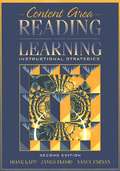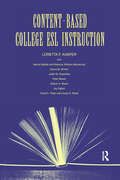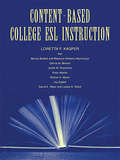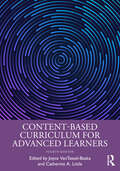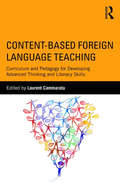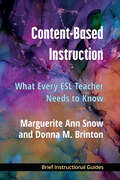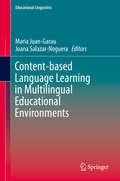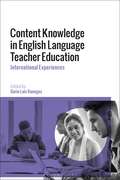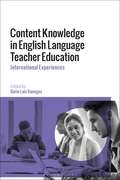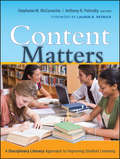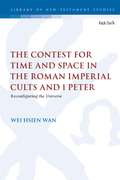- Table View
- List View
Content Area Reading and Learning: Instructional Strategies
by Diane Lapp James Flood Nancy FarnanHow can teachers make content-area learning more accessible to their students? This text addresses instructional issues and provides a wealth of classroom strategies to help all middle and secondary teachers effectively enable their students to develop both content concepts and strategies for continued learning. The goal is to help teachers model, through excellent instruction, the importance of lifelong content-area learning. This working textbook provides students maximum interaction with the information, strategies, and examples presented in each chapter. Content Area Reading and Learning: Instructional Strategies, Third Edition is organized around five themes: Content Area Reading: An Overview The Teacher and the Text The Students The Instructional Program School Culture and Environment in Middle and High School Classrooms Pedagogical features: Each chapter includes a graphic organizer, a chapter overview, a Think Before Reading Activity, one or more Think While Reading Activities, and a Think After Reading Activity. The activities present questions and scenarios designed to integrate students’ previous knowledge and experience with their new learnings about issues related to content area reading, literacy, and learning, and to serve as catalysts for thinking and discussions. New in the Third Edition The latest information on literacy strategies in every content area Research-based strategies for teaching students to read informational texts Up-to-date information for differentiating instruction for English-speaking and non-English speaking students An examination of youth culture and the role it plays in student learning A look at authentic learning in contexts related to the world of work Ways of using technology and media literacy to support content learning Suggestions for using writing in every content area to enhance student learning Ideas for using multiple texts for learning content A focus on the assessment-instruction connection Strategies for engaging and motivating students Content Area Reading and Learning: Instructional Strategies, Third Edition, is intended as a primary text for courses on middle and high school content area literacy and learning.
Content Area Reading and Learning: Instructional Strategies
by Diane Lapp James Flood Nancy FarnanHow can teachers make content-area learning more accessible to their students? This text addresses instructional issues and provides a wealth of classroom strategies to help all middle and secondary teachers effectively enable their students to develop both content concepts and strategies for continued learning. The goal is to help teachers model, through excellent instruction, the importance of lifelong content-area learning. This working textbook provides students maximum interaction with the information, strategies, and examples presented in each chapter. Content Area Reading and Learning: Instructional Strategies, Third Edition is organized around five themes: Content Area Reading: An Overview The Teacher and the Text The Students The Instructional Program School Culture and Environment in Middle and High School Classrooms Pedagogical features: Each chapter includes a graphic organizer, a chapter overview, a Think Before Reading Activity, one or more Think While Reading Activities, and a Think After Reading Activity. The activities present questions and scenarios designed to integrate students’ previous knowledge and experience with their new learnings about issues related to content area reading, literacy, and learning, and to serve as catalysts for thinking and discussions. New in the Third Edition The latest information on literacy strategies in every content area Research-based strategies for teaching students to read informational texts Up-to-date information for differentiating instruction for English-speaking and non-English speaking students An examination of youth culture and the role it plays in student learning A look at authentic learning in contexts related to the world of work Ways of using technology and media literacy to support content learning Suggestions for using writing in every content area to enhance student learning Ideas for using multiple texts for learning content A focus on the assessment-instruction connection Strategies for engaging and motivating students Content Area Reading and Learning: Instructional Strategies, Third Edition, is intended as a primary text for courses on middle and high school content area literacy and learning.
Content-Based College ESL Instruction
by Loretta F. Kasper Marcia Babbitt Rebecca William Mlynarczyk Donna M. Brinton Judith W. RosenthalThis book is carefully designed to inform and train readers in the techniques of content-based ESL instruction and to assist them in developing and implementing content-based materials and programs appropriate to their educational institutions and situations. Every chapter presents a balance of theory and practice, focusing on a detailed description, with clear examples of classroom practices including information, suggestions, and instructional tools. Each chapter addresses assessment issues as they apply to the particular methodology described.
Content-Based College ESL Instruction
by Loretta F. Kasper Marcia Babbitt Rebecca William Mlynarczyk Donna M. Brinton Judith W. RosenthalThis book is carefully designed to inform and train readers in the techniques of content-based ESL instruction and to assist them in developing and implementing content-based materials and programs appropriate to their educational institutions and situations. Every chapter presents a balance of theory and practice, focusing on a detailed description, with clear examples of classroom practices including information, suggestions, and instructional tools. Each chapter addresses assessment issues as they apply to the particular methodology described.
Content-Based Curriculum for Advanced Learners
by Joyce VanTassel-Baska and Catherine A. LittleThe fourth edition of Content-Based Curriculum for High-Ability Learners provides readers with a complete and up-to-date introduction to core elements of curriculum development in gifted education with implications for school-based implementation. Written by key experts in the field, this text is essential to the development of high-powered, rich, and complex curricula that treat content, process, product, and concept development considerations as equal partners in the task of educating gifted learners. Along with revised chapters, this edition contains new chapters on culturally responsive curriculum, the performing arts, robotics, and engineering design, as well as social and emotional learning. Additional material concerning talent trajectories across the lifespan accompanies a discussion of honors curriculum in higher education, rounding out this comprehensive resource. This master text is a must read for educators interested in executing effective curriculum and instructional interventions to support learning for gifted and advanced learners.
Content-Based Curriculum for Advanced Learners
by Joyce VanTassel-Baska Catherine A. LittleThe fourth edition of Content-Based Curriculum for High-Ability Learners provides readers with a complete and up-to-date introduction to core elements of curriculum development in gifted education with implications for school-based implementation. Written by key experts in the field, this text is essential to the development of high-powered, rich, and complex curricula that treat content, process, product, and concept development considerations as equal partners in the task of educating gifted learners. Along with revised chapters, this edition contains new chapters on culturally responsive curriculum, the performing arts, robotics, and engineering design, as well as social and emotional learning. Additional material concerning talent trajectories across the lifespan accompanies a discussion of honors curriculum in higher education, rounding out this comprehensive resource. This master text is a must read for educators interested in executing effective curriculum and instructional interventions to support learning for gifted and advanced learners.
Content-Based Curriculum for High-Ability Learners
by Joyce VanTassel-Baska Ed.D;Ph.DContent-Based Curriculum for High-Ability Learners (3rd ed.) provides a solid introduction to core elements of curriculum development in gifted education and implications for school-based implementation. Written by experts in the field, this text uses cutting-edge design techniques and aligns core content with national and state standards. In addition to revised chapters, the third edition contains new chapters on topics including special populations of gifted learners, critical thinking, leadership, and university-level honors curriculum.The text identifies fundamental principles of curriculum that support advanced and high-potential learners: accelerated learning within the core content areas, use of higher order processes and products, and concept development. These emphases form threads across chapters in core content areas, including language arts, mathematics, science, social studies, world languages, and the arts. Additional chapters explore structures to support implementation, including alignment with standards, assessment of learning, counseling, and promoting exemplary teacher practice through professional development.
Content-Based Curriculum for High-Ability Learners
Content-Based Curriculum for High-Ability Learners (3rd ed.) provides a solid introduction to core elements of curriculum development in gifted education and implications for school-based implementation. Written by experts in the field, this text uses cutting-edge design techniques and aligns core content with national and state standards. In addition to revised chapters, the third edition contains new chapters on topics including special populations of gifted learners, critical thinking, leadership, and university-level honors curriculum.The text identifies fundamental principles of curriculum that support advanced and high-potential learners: accelerated learning within the core content areas, use of higher order processes and products, and concept development. These emphases form threads across chapters in core content areas, including language arts, mathematics, science, social studies, world languages, and the arts. Additional chapters explore structures to support implementation, including alignment with standards, assessment of learning, counseling, and promoting exemplary teacher practice through professional development.
Content-Based Foreign Language Teaching: Curriculum and Pedagogy for Developing Advanced Thinking and Literacy Skills
by Laurent CammarataPushing the field forward in critically important ways, this book offers clear curricular directions and pedagogical guidelines to transform foreign language classrooms into environments where stimulating intellectual curiosity and tapping critical thinking abilities are as important as developing students’ linguistic repertoires. The case is made for content-based instruction—an approach to making FL classrooms sites where intellectually stimulating explorations are the norm rather than the exception. The book explicitly describes in detail how teachers could and should use content-based instruction, explains how integration of content and language aims can be accomplished within a program, identifies essential strategies to support this curricular and pedagogical approach, discusses issues of assessment within this context, and more. Content-Based Foreign Language Teaching provides theoretical perspectives and empirical evidence for reforming curricula and instruction, describes models and curriculum planning strategies that support implementation of well-balanced FL programs, explores the transformative potential of critical pedagogy in the FL classroom, and offers illustrations of secondary and post-secondary language programs that have experimented with alternative approaches. Advancing alternatives to conventional curriculum design, this volume posits meaning-oriented approaches as necessary to create language programs that make a great difference in the overall educational lives of learners
Content-Based Foreign Language Teaching: Curriculum and Pedagogy for Developing Advanced Thinking and Literacy Skills
by Laurent CammarataPushing the field forward in critically important ways, this book offers clear curricular directions and pedagogical guidelines to transform foreign language classrooms into environments where stimulating intellectual curiosity and tapping critical thinking abilities are as important as developing students’ linguistic repertoires. The case is made for content-based instruction—an approach to making FL classrooms sites where intellectually stimulating explorations are the norm rather than the exception. The book explicitly describes in detail how teachers could and should use content-based instruction, explains how integration of content and language aims can be accomplished within a program, identifies essential strategies to support this curricular and pedagogical approach, discusses issues of assessment within this context, and more. Content-Based Foreign Language Teaching provides theoretical perspectives and empirical evidence for reforming curricula and instruction, describes models and curriculum planning strategies that support implementation of well-balanced FL programs, explores the transformative potential of critical pedagogy in the FL classroom, and offers illustrations of secondary and post-secondary language programs that have experimented with alternative approaches. Advancing alternatives to conventional curriculum design, this volume posits meaning-oriented approaches as necessary to create language programs that make a great difference in the overall educational lives of learners
Content-Based Instruction: What Every ESL Teacher Needs to Know
by Ann Snow Donna BrintonThis book introduces readers to the concept of Content-Based Instruction (CBI) through a brief history and countless examples of the many ways this approach can be applied across settings and programs. Whether readers want to deepen their understanding of CBI or get ideas for their own teaching situation, this book provides an overview of CBI and the process of implementing it. The book discusses the three prototype models (theme-based, sheltered, and adjunct), new models (sustained content language teaching, content and language-integrated learning, English-medium instruction, adjunct models, and other hybrid models), and a research-based rationale for using CBI in the classroom. Each section includes reflection questions designed to guide readers to consider how best to implement CBI in their course and program.
Content-based Language Learning in Multilingual Educational Environments (Educational Linguistics #23)
by Maria Juan-Garau Joana Salazar-NogueraThe spread of English as an international language along with the desire to maintain local languages lead us to consider multilingualism as the norm rather than the exception. Consequently, bi/multilingual education has bloomed over the last decades. This volume deals with one such type of education currently in the spotlight as an essentially European strategy to multilingualism, CLIL (Content and Language Integrated Learning), in which curricular content is taught through a foreign language. The book contributes new empirical evidence on its effects on linguistic and attitudinal outcomes focusing on bi/multilingual learners who acquire English as an additional language. Moreover, it presents critical analyses of factors influencing multilingual education, the effects of CLIL on both language and content learning, and the contrast between CLIL and other models of instruction. The research presented suggests that CLIL can greatly enhance language acquisition in multilingual settings.
Content Knowledge in English Language Teacher Education: International Experiences
by Darío Luis BanegasContent Knowledge in English Language Teacher Education provides original professional experiences and research accounts of teaching language in the specific context of English language teacher education programmes in diverse international settings, with contributions from Argentina, Australia, Chile, China, Ecuador, Japan, Mexico, the USA and Turkey. The volume focuses on how teacher educators plan and deliver modules which help future teachers understand English as a system and develop English language proficiency. The contributors describe and analyse their professional practices in designing, delivering and evaluating modules or courses on understanding the English language as a system, i.e. content knowledge, exploring the teaching of elements such as phonetics, phonology, grammar, pragmatics, philology, and discourse analysis. In addition, they draw on their vast professional experience to explore how to successfully develop competence and language skills in English so that teachers can become models and proficient users of the language for their students. The contributions range from more historical and functionally linguistic focused chapters to more sociocultural explorations of teaching English to future teachers including interculturality, multilingualism, World Englishes, critical thinking skills, academic writing, and literacy through literature. The accounts shed light on the diverse practices of educators from many different countries, contexts, and cultural and linguistic backgrounds, drawing links between policy and practice, to locate much of English language teacher education and curriculum development outside the so-called 'inner circle' of native English-language speaking contexts, practitioners, and researchers.
Content Knowledge in English Language Teacher Education: International Experiences
Content Knowledge in English Language Teacher Education provides original professional experiences and research accounts of teaching language in the specific context of English language teacher education programmes in diverse international settings, with contributions from Argentina, Australia, Chile, China, Ecuador, Japan, Mexico, the USA and Turkey. The volume focuses on how teacher educators plan and deliver modules which help future teachers understand English as a system and develop English language proficiency. The contributors describe and analyse their professional practices in designing, delivering and evaluating modules or courses on understanding the English language as a system, i.e. content knowledge, exploring the teaching of elements such as phonetics, phonology, grammar, pragmatics, philology, and discourse analysis. In addition, they draw on their vast professional experience to explore how to successfully develop competence and language skills in English so that teachers can become models and proficient users of the language for their students. The contributions range from more historical and functionally linguistic focused chapters to more sociocultural explorations of teaching English to future teachers including interculturality, multilingualism, World Englishes, critical thinking skills, academic writing, and literacy through literature. The accounts shed light on the diverse practices of educators from many different countries, contexts, and cultural and linguistic backgrounds, drawing links between policy and practice, to locate much of English language teacher education and curriculum development outside the so-called 'inner circle' of native English-language speaking contexts, practitioners, and researchers.
Content Management for E-Learning
by Núria Ferran Ferran Ferrer and Julià Minguillón Minguillón AlfonsoThe increasing growth in the use of e-learning environments, in which education is delivered and supported through information and communication technologies, has brought new challenges to academic institutions. From all the current definitions of e-learning, it can be seen that learning contents are one of the key issues for a successful e-learning experience. Therefore, there is a real need for academic staff, managers and librarians to re-think the whole process of delivering courses, information resources and information services. The book focuses on defining content management and its relationship with knowledge management, providing perspectives on how the semantic web could complement content management, how to deal with copyright restrictions, and how to describe information competencies and skills required and acquired by teachers and students in virtual environments. Offered is a design project for managing digital content for classical and distance education institutions, covering all the aspects related to the content lifecycle, integrating it into the learning process. Practical aspects such as standards for content e-learning management, a review of existing experiences of learning repositories, and a survey of available platforms for delivering courses and providing access to information resources is also covered. Lastly, the book addresses the three main factors which make it crucial in the current context: first, the web 2.0 paradigm, which breaks the content producer-consumer barrier; second, the open content movement for educational purposes, which changes the knowledge management transference model; and third, the new European Higher Education Area, where the concept of content needs to be rethought.
Content Matters: A Disciplinary Literacy Approach to Improving Student Learning
by Stephanie M. McConachie Anthony R. PetroskyAn authoritative guide for improving teaching, learning, and literacy in content area classrooms This book introduces teachers to the Disciplinary Literacy instructional framework developed by the Institute for Learning, University of Pittsburgh. Grounded in the Principles of Learning developed by acclaimed educator Lauren Resnick, the framework is designed to prepare students, grades 6 and up, to master the rigorous academic content learning required for college success. Unlike 'generic' teaching models, the framework is specifically tailored for each of the content disciplines. Highly practical, the book shows teachers how to integrate literacy development and thinking practices into their routine content instruction, with separate chapters devoted to math, science, history, and English/language arts. The book also shows how school instructional leaders can support teachers in learning and using this instructional approach. Offers an innovative approach for improving literacy, thinking, and content learning in secondary students Includes detailed instructional guidance plus numerous classroom examples of lessons, dialogs, and teaching routines Features chapters on each of the content areas-math, science, language arts, and social sciences Provides leadership guidance in implementing the method Foreword written by internationally acclaimed educator and cognitive scientist Lauren Resnick
Content Matters: A Disciplinary Literacy Approach to Improving Student Learning
by Stephanie M. McConachie Anthony R. PetroskyAn authoritative guide for improving teaching, learning, and literacy in content area classrooms This book introduces teachers to the Disciplinary Literacy instructional framework developed by the Institute for Learning, University of Pittsburgh. Grounded in the Principles of Learning developed by acclaimed educator Lauren Resnick, the framework is designed to prepare students, grades 6 and up, to master the rigorous academic content learning required for college success. Unlike 'generic' teaching models, the framework is specifically tailored for each of the content disciplines. Highly practical, the book shows teachers how to integrate literacy development and thinking practices into their routine content instruction, with separate chapters devoted to math, science, history, and English/language arts. The book also shows how school instructional leaders can support teachers in learning and using this instructional approach. Offers an innovative approach for improving literacy, thinking, and content learning in secondary students Includes detailed instructional guidance plus numerous classroom examples of lessons, dialogs, and teaching routines Features chapters on each of the content areas-math, science, language arts, and social sciences Provides leadership guidance in implementing the method Foreword written by internationally acclaimed educator and cognitive scientist Lauren Resnick
The Content Of Science: A Constructive Approach To Its Teaching And Learning
by Peter J. Fensham Richard F. Gunstone Richard T. WhiteFirst published in 1994. Routledge is an imprint of Taylor & Francis, an informa company.
The Content Of Science: A Constructivist Approach To Its Teaching And learning
by Peter J. Fensham Richard F. Gunstone Richard T. WhiteFirst published in 1994. Routledge is an imprint of Taylor & Francis, an informa company.
Contentious Curricula: Afrocentrism and Creationism in American Public Schools
by Amy J. BinderThis book compares two challenges made to American public school curricula in the 1980s and 1990s. It identifies striking similarities between proponents of Afrocentrism and creationism, accounts for their differential outcomes, and draws important conclusions for the study of culture, organizations, and social movements. Amy Binder gives a brief history of both movements and then describes how their challenges played out in seven school districts. Despite their very different constituencies--inner-city African American cultural essentialists and predominately white suburban Christian conservatives--Afrocentrists and creationists had much in common. Both made similar arguments about oppression and their children's well-being, both faced skepticism from educators about their factual claims, and both mounted their challenges through bureaucratic channels. In each case, challenged school systems were ultimately able to minimize or reject challengers' demands, but the process varied by case and type of challenge. Binder finds that Afrocentrists were more successful in advancing their cause than were creationists because they appeared to offer a solution to the real problem of urban school failure, met with more administrative sympathy toward their complaints of historic exclusion, sought to alter lower-prestige curricula (history, not science), and faced opponents who lacked a legal remedy comparable to the rule of church-state separation invoked by creationism's opponents. Binder's analysis yields several lessons for social movements research, suggesting that researchers need to pay greater attention to how movements seek to influence bureaucratic decision making, often from within. It also demonstrates the benefits of examining discursive, structural, and institutional factors in concert.
Contentious Curricula: Afrocentrism and Creationism in American Public Schools (PDF)
by Amy J. BinderThis book compares two challenges made to American public school curricula in the 1980s and 1990s. It identifies striking similarities between proponents of Afrocentrism and creationism, accounts for their differential outcomes, and draws important conclusions for the study of culture, organizations, and social movements. Amy Binder gives a brief history of both movements and then describes how their challenges played out in seven school districts. Despite their very different constituencies--inner-city African American cultural essentialists and predominately white suburban Christian conservatives--Afrocentrists and creationists had much in common. Both made similar arguments about oppression and their children's well-being, both faced skepticism from educators about their factual claims, and both mounted their challenges through bureaucratic channels. In each case, challenged school systems were ultimately able to minimize or reject challengers' demands, but the process varied by case and type of challenge. Binder finds that Afrocentrists were more successful in advancing their cause than were creationists because they appeared to offer a solution to the real problem of urban school failure, met with more administrative sympathy toward their complaints of historic exclusion, sought to alter lower-prestige curricula (history, not science), and faced opponents who lacked a legal remedy comparable to the rule of church-state separation invoked by creationism's opponents. Binder's analysis yields several lessons for social movements research, suggesting that researchers need to pay greater attention to how movements seek to influence bureaucratic decision making, often from within. It also demonstrates the benefits of examining discursive, structural, and institutional factors in concert.
The Contest for Knowledge: Debates over Women's Learning in Eighteenth-Century Italy (The Other Voice in Early Modern Europe)
by Maria Gaetana Agnesi Diamante Medaglia Faini Aretafila Savini de' Rossi Accademia de' RicovratiAt a time when women were generally excluded from scholarly discourse in the intellectual centers of Europe, four extraordinary female letterate proved their parity as they lectured in prominent scientific and literary academies and published in respected journals. During the Italian Enlightenment, Maria Gaetana Agnesi, Giuseppa Eleonora Barbapiccola, Diamante Medaglia Faini, and Aretafila Savini de' Rossi were afforded unprecedented deference in academic debates and epitomized the increasing ability of women to influence public discourse. The Contest for Knowledge reveals how these four women used the methods and themes of their male counterparts to add their voices to the vigorous and prolific debate over the education of women during the eighteenth century. In the texts gathered here, the women discuss the issues they themselves thought most urgent for the equality of women in Italian society specifically and in European culture more broadly. Their thoughts on this important subject reveal how crucial the eighteenth century was in the long history of debates about women in the academy.
The Contest for Knowledge: Debates over Women's Learning in Eighteenth-Century Italy (The Other Voice in Early Modern Europe)
by Maria Gaetana Agnesi Diamante Medaglia Faini Aretafila Savini de' Rossi Accademia de' RicovratiAt a time when women were generally excluded from scholarly discourse in the intellectual centers of Europe, four extraordinary female letterate proved their parity as they lectured in prominent scientific and literary academies and published in respected journals. During the Italian Enlightenment, Maria Gaetana Agnesi, Giuseppa Eleonora Barbapiccola, Diamante Medaglia Faini, and Aretafila Savini de' Rossi were afforded unprecedented deference in academic debates and epitomized the increasing ability of women to influence public discourse. The Contest for Knowledge reveals how these four women used the methods and themes of their male counterparts to add their voices to the vigorous and prolific debate over the education of women during the eighteenth century. In the texts gathered here, the women discuss the issues they themselves thought most urgent for the equality of women in Italian society specifically and in European culture more broadly. Their thoughts on this important subject reveal how crucial the eighteenth century was in the long history of debates about women in the academy.
The Contest for Knowledge: Debates over Women's Learning in Eighteenth-Century Italy (The Other Voice in Early Modern Europe)
by Maria Gaetana Agnesi Diamante Medaglia Faini Aretafila Savini de' Rossi Accademia de' RicovratiAt a time when women were generally excluded from scholarly discourse in the intellectual centers of Europe, four extraordinary female letterate proved their parity as they lectured in prominent scientific and literary academies and published in respected journals. During the Italian Enlightenment, Maria Gaetana Agnesi, Giuseppa Eleonora Barbapiccola, Diamante Medaglia Faini, and Aretafila Savini de' Rossi were afforded unprecedented deference in academic debates and epitomized the increasing ability of women to influence public discourse. The Contest for Knowledge reveals how these four women used the methods and themes of their male counterparts to add their voices to the vigorous and prolific debate over the education of women during the eighteenth century. In the texts gathered here, the women discuss the issues they themselves thought most urgent for the equality of women in Italian society specifically and in European culture more broadly. Their thoughts on this important subject reveal how crucial the eighteenth century was in the long history of debates about women in the academy.
The Contest for Time and Space in the Roman Imperial Cults and 1 Peter: Reconfiguring the Universe (The Library of New Testament Studies)
by Wei Hsien WanWei Hsien Wan builds on the work of David Horrell and Travis Williams for his argument that the letter of 1 Peter engages in a subtle, calculated form of resistance to Rome, which has often gone undetected. Whilst previous discussion of the topic has remained largely focused on the letter's stance toward specific Roman institutions, such as the emperor, household structures, and the imperial cults, Wan takes the conversation beyond these confines and examines 1 Peter's critique of the Roman Empire in terms of its ideology or worldview. Using the work of James Scott to conceptualise ideological resistance against domination, Wan considers how the imperial cults of Anatolia and 1 Peter offered distinct constructions of time and space - that is, how they envisioned reality differently. Insofar as these differences led to divergent ways of conceiving the social order, they acquired political power and generated potential for conflict. Wan thus argues that 1 Peter confronts Rome on a cosmic scale with its alternative construal of time and space, and examines the evidence that the Petrine author consciously, if cautiously, interrogated the imperial imagination at its most foundational levels, and set forth in its place a theocentric, Christological understanding of the world.
